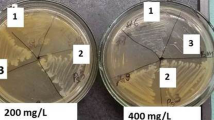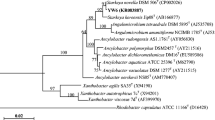Abstract
Four bacterial strains from glyphosate- or alkylphosphonates-contaminated soils were tested for ability to utilize different organophosphonates. All studied strains readily utilized methylphosphonic acid and a number of other phosphonates, but differed in their ability to degrade glyphosate. Only strains Ochrobactrum anthropi GPK 3 and Achromobacter sp. Kg 16 utilized this compound after isolation from enrichment cultures with glyphosate. Achromobacter sp. MPK 7 from the same enrichment culture, similar to Achromobacter sp. MPS 12 from methylphosphonate-polluted source, required adaptation to growth on GP. Studied strains varied significantly in their growth parameters, efficiency of phosphonates degradation and characteristic products of this process, as well as in their energy metabolism. These differences give grounds to propose a possible model of interaction between these strains in microbial consortium in phosphonate-contaminated soils.


Similar content being viewed by others
References
Akimenko VK (1981) Cyanide-resistant respiration of microorganisms. Uspekhi microbiologii 16:3–20
Bai SH, Ogbourne SM (2016) Glyphosate: environmental contamination, toxicity and potential risks to human health via food contamination. Environ Sci Pollut Res Int 23:18988–19001
Bujacz B, Wieczorek P, Krzysko-Lupicka T, Golab Z, Lejczak B, Kafarski P (1995) Organophosphonate utilization by the wild-type strain of Penicillum notatum. Appl Environ Microbiol 61:2905–2910
Carson DB, Heitkamp MA, Hallas LE (1997) Biodegradation of N-phosphonomethyliminodiacetic acid by microorganisms from industrial activated sludge. Can J Microbiol 43:97–101
Castle LA, Siehl DL, Gorton R, Patten PA, Chen YH, Bertain S, Cho H-J, Duck N, Wong J, Liu D, Lassner MW (2004) Discovery and directed evolution of a glyphosate tolerance gene. Science 304:1151–1154
Dalrymple BP, Peters JM, Vuocolo T (1992) Characterisation of genes encoding two novel members of the aldo-keto reductase superfamily. Biochem Int 28:651–657
Dick RE, Quinn JP (1995) Glyphosate-degrading isolates from environmental samples: occurrence and pathways of degradation. Appl Microbiol Biotechnol 43:545–550
Duke SO (2011) Glyphosate degradation in glyphosate-resistant and -susceptible crops and weeds. J Agric Food Chem 59:5835–5841
Ermakova IT, Shushkova TV, Leontievsky AA (2008) Microbial degradation of organophosphonates by soil bacteria. Microbiology (Moscow) 77:615–620
Ermakova IT, Kiseleva NI, Shushkova T, Zharikov M, Zharikov GA, Leontievsky AA (2010) Bioremediation of glyphosate-contaminated soils. Appl Microbiol Biotechnol 88:585–594
Fitzgibbon JE, Braymer HD (1990) Cloning of a gene from Pseudomonas sp. strain PG2982 conferring increased glyphosate resistance. Appl Environ Microbiol 56:3382–3388
Gard JK, Feng PCC, Hutton WC (1997) Nuclear magnetic resonance timecourse studies of glyphosate metabolism by microbial isolates. Xenobiotica 27:633–644
Hadi F, Mousavi A, Akbari NK, Ghaderi TH, Hatef SA (2013) New bacterial strain of the genus Ochrobactrum with glyphosate-degrading activity. J Environ Sci Health B 48:208–213
Hallas LE, Adams WJ, Heitkamp MA (1992) Glyphosate degradation by immobilized bacteria: field studies with industrial wastewater effluent. Appl Environ Microbiol 58:1215–1219
Hess HH, Derr JE (1975) Assay of inorganic and organic phosphorus in the 0.1–5 nanomole range. Anal Biochem 63:607–613
Hove-Jensen B, Zechel DL, Jochimsen B (2014) Utilization of glyphosate as phosphate source: biochemistry and genetics of bacterial carbon–phosphorus lyase. Microbiol Mol Biol Rev 78:176–197
Jacob GS, Garbow JR, Hallas LE, Kimack NM, Kishore GM (1988) Metabolism of glyphosate in Pseudomonas sp. strain LBr. Appl Environ Microbiol 54:2953–2958
Kamat SS, Raushel FM (2013) The enzymatic conversion of phosphonates to phosphate by bacteria. Curr Opin Chem Biol 17:589–596
Kertesz M, Elgorriaga A, Amrhein N (1991) Evidence for two distinct phosphonate-degrading enzymes (C–P lyases) in Arthrobacter sp. GLP-1. Biodegradation 2:53–59
Kishore GM, Barry GF (1992) Glyphosate tolerant plants. International patent WO92/00377
Liu C-M, McLean PA, Sookdeo CC, Cannon FC (1991) Degradation of the herbicide glyphosate by members of the family Rhizobiaceae. Appl Environ Microbiol 57:1799–1804
Matys SV, Laurinavichus KS, Krupyanko VI, Nesmeyanova MA (2001) Optimization of degradation of methylphosphonate—analogue of toxic pollutants with direct C–P bond by Escherichia coli. Process Biochem 36:821–827
McAuliffe KS, Hallas LE, Kulpa CF (1990) Glyphosate degradation by Agrobacterium radiobacter isolated from activated sludge. J Ind Microbiol 6:219–221
McGrath JW, Chin JP, Quinn JP (2013) Organophosphonates revealed: new insights into the microbial metabolism of ancient molecules. Nat Rev Microbiol 11:412–419
Mesnage R, Defarge N, Spiroux de Vendomois J, Seralini GE (2015) Potential toxic effects of glyphosate and its commercial formulations below regulatory limits. Food Chem Toxicol 84:133–153
Novikov YV, Lastochkina KO, Boldina ZN (1990) Metody issledovaniya kachestva vody vodoemov (Methods of investigation of reservoir water quality). Meditsina, Moscow, pp 114–119
Peñaloza-Vazquez A, Mena GL, Herrera-Estrella L, Bauley AM (1995) Cloning and sequencing of the genes involved in glyphosate utilization by Pseudomonas pseudomallei. Appl Environ Microbiol 61:538–543
Pipke R, Amrhein N (1988) Degradation of the phosphonate herbicide glyphosate by Arthrobacter atrocyaneus ATCC 13752. Appl Environ Microbiol 54:1293–1296
Pipke R, Amrhein N, Jacob GS, Schaefer J, Kishore GM (1987) Metabolism of glyphosate in an Arthrobacter sp. GLP-1. Eur J Biochem 165:267–273
Quinn JP, Peden JMM, Dick RE (1988) Glyphosate tolerance and utilization by the microflora of soils treated with the herbicide. Appl Microbiol Biotechnol 29:511–516
Quinn JP, Peden JMM, Dick RE (1989) Carbon–phosphorus bond cleavage by Gram-positive and Gram-negative soil bacteria. Appl Microbiol Biotechnol 31:283–287
Schowanek D, Verstraete W (1990) Phosphonate utilization by bacterial cultures and enrichments from environmental samples. Appl Environ Microbiol 56:895–903
Shushkova TV, Ermakova IT, Sviridov AV, Leontievsky AA (2012) Biodegradation of glyphosate by soil bacteria: optimization of cultivation and the method for active biomass storage. Microbiology (Moscow) 81:44–50
Shushkova TV, Vinokurova NG, Baskunov BP, Zelenkova NF, Sviridov AV, Ermakova IT, Leontievsky AA (2016) Glyphosate acetylation as a specific trait of Achromobacter sp. Kg 16 physiology. Appl Microbiol Biotechnol 100:847–855
Siehl DL, Castle LA, Gorton R, Keenan RJ (2007) The molecular basis of glyphosate resistance by an optimized microbial acetyltransferase. J Biol Chem 282:11446–11455
Sviridov AV, Shushkova TV, Zelenkova NF, Vinokurova NG, Morgunov IG, Ermakova IT, Leontievsky AA (2012) Distribution of glyphosate and methylphosphonate catabolism systems in soil bacteria Ochrobactrum anthropi and Achromobacter sp. Appl Microbiol Biotechnol 93:787–796
Sviridov AV, Shushkova TV, Ermakova IT, Ivanova EV, Leontievsky AA (2014) Glyphosate: safety risks, biodegradation, and bioremediation. In: Cao G, Orru R (eds) Current environmental issues and challenges. Springer, Dodrecht, pp. 183–192
Torstensson L (1985) Behaviour of glyphosate in soils and its degradation. In: Grossbard E, Atkinson D (eds) The herbicide glyphosate. Butterworths, London, pp 137–149
Wackett LP, Shames SL, Venditti CP, Walsh CT (1987) Bacterial carbon–phosphorus lyase: products, rates, and regulation of phosphonic and phosphinic acid metabolism. J Bacteriol 169:710–717
White AK, Metcalf WW (2007) Microbial metabolism of reduced phosphorus compounds. Annu Rev Microbiol 61:379–400
Acknowledgements
The work was supported by Russian Foundation for Basic Research (Project 14-04-01230).
Author information
Authors and Affiliations
Corresponding author
Ethics declarations
Conflict of interest
The authors declare that they have no competing interests.
Ethical approval
This article does not contain any studies with human participants or animals performed by any of the authors.
Additional information
Communicated by Erko Stackebrandt.
Rights and permissions
About this article
Cite this article
Ermakova, I.T., Shushkova, T.V., Sviridov, A.V. et al. Organophosphonates utilization by soil strains of Ochrobactrum anthropi and Achromobacter sp.. Arch Microbiol 199, 665–675 (2017). https://doi.org/10.1007/s00203-017-1343-8
Received:
Revised:
Accepted:
Published:
Issue Date:
DOI: https://doi.org/10.1007/s00203-017-1343-8




